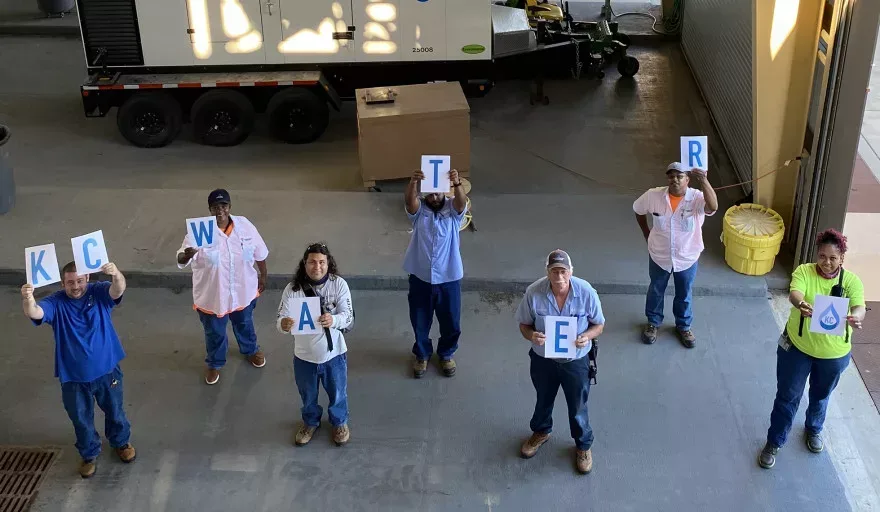Public utilities service KC Water has employed an innovative asset management strategy to streamline operations and reduce maintenance costs.
INTRODUCTION
Scott Parker started his career in city management, which he quickly realised wasn’t for him.
“It didn’t satisfy my interest in exploring more deeply why cities look the way they do, why and how they operate. Infrastructure was a place that really appealed to me – it’s the baseline for understanding what makes a place a place,” he tells me.
After making the transition to Project Manager within capital infrastructure, he worked for a city which has installed hundreds of millions of dollars of green infrastructure, and was instructed to figure out the best way to maintain it.
It was then he hit upon asset management, a concept that is becoming more important in the infrastructure sector. In this context, an asset refers to a valuable resource, which, in utilities, largely consist of physical resources – such as a sewer line or a utility grid – that need to be maintained, rehabilitated and replaced at specific intervals. This process combines data-driven insights with operational knowledge and a robust problem-solving approach.
This experience later led to Parker being appointed as Asset Manager at KC Water, Kansas City’s public water service.
ASSET MANAGEMENT AND PUBLIC INFRASTRUCTURE
According to Parker, there are three things driving the need for asset management in the public utilities space.
The first of these is an increasing need for repairs.
“In the US, a lot of our infrastructure was installed in the first half of the 20th century, so assets are starting to fail on a more regular basis,” Parker explains. “They are incredibly expensive to replace, and those cost drivers are much more of a focus of the utilities’ industry nowadays, whereas before it was largely focused on growth and expanding infrastructure.”
“The second thing is as a result of those assets failing, and various regulations we are required to meet, the cost of utilities service is far higher than ever before,” the Asset Manager says. “And in the water industry, in the U.S. at least, there’s only one place to go to support the cost of operations and repairs, and that’s your customers directly.”
Water rates have therefore risen exponentially over the past two decades. Understandably, politicians don’t like passing those rate increases, which pressures water professionals to maximise the benefits of their investments and look to reduce operational costs.
The third driver, according to Parker, is the power of the data acquisition tools that public utilities have at their disposal and the expectations around what those tools produce. Better data is supposed to enable more informed decisions about the assets that they have. However, he believes that data collection and analysis isn’t always implemented correctly.
“The expansion in the number of tools that collect data and the computing power to house it have made data very easy to get. But information, which is data that is organized or structured in a way to make it useful to a particular context, is much harder to obtain. The sources of data are multifaceted; maybe one tool was brought in to gather one type of data, and now we try and use it in five other domains it wasn’t designed for,” he says. “This can lead to inconsistencies or even confusion when trying to make decisions based on what that data is telling you.
“Our asset management team has focused a lot of our time and energy on standardizing what we put into those decision support tools, and every year the integration and aggregation gets a little better, giving us better insight, and, hopefully, leading to better decisions.”
Utilities asset management is therefore driven by the need to rehabilitate assets in the most cost-effective way possible, using the information at one’s disposal.
“It’s taking the best bits of engineering, finance and operations and combines them with data systems that represent the assets to provide information to the people that make the decisions about those assets,” Parker concludes.
THE CHALLENGES AND REWARDS OF ASSET MANAGEMENT OF KC WATER
For an asset management programme to run smoothly, then, it is necessary to have access to large amounts of accurate, high quality data. It is, Parker says, the lifeblood of the program. However, when he started working with KC Water (initially, as an independent consultant), the data sometimes confused, rather than represented, the condition of the assets.
In the department’s computerized maintenance management system (CMMS), for example, one asset might be categorized in multiple ways through the listing of different components. How each component related to each other was not always clear.
“Looking up one asset, you might only see 20 percent of the work that had been done on it because the definition of an asset was not the same across the board. This made it difficult to see in one place all of the work that had been done on one particular asset,” Parker tells me. “In that system, there was no strict governance policy in that system about how we classify an asset, or who gets to create an asset, or how we retire an asset when it dies.” the Asset Manager explains.
Another challenge was providing timely information to stakeholders to avoid confusion or duplication of work. This was particular important for staff and the multiple contractors assigned to do work on the Smart Sewer program.
Both groups were working on the same assets (sanitary sewers) in the same geographic area, but at different times. Besides improving the condition of the infrastructure, this work was producing tons of data on literally thousands of assets. The question was how to provide timely information to all of the stakeholders involved in the process.
Parker and his team considered many options to solve this problem. It wasn’t feasible to have hundreds of contractors going through KC Water’s firewall to log their work directly into the CMMS. The team did not have any funds available to purchase extra tools that might benefit the handling of data. Ultimately, it was decided that creating an internally developed, web-based application with built-in governance rules and requirements for data entry into the CMMS was the best way forward.
Utilising the expertise of internal staff (applications development, operations, engineering and asset management) and consultants who were charged with helping deliver the Smart Sewer program, the tool has been in place for just over two years. It has successfully improved the quality of the lifeblood of asset management. The tool is utilized on more than 40 projects, encompassing 80-plus users and generating 35,000 work orders in the Smart Sewer program alone.
“To my knowledge, we have been able to absorb millions of dollars of work without replication of work,” Parker tells us proudly, “and we didn’t spend an extra dime – we just used what we had and a robust problem-solving approach.
“We took something that was possibly dysfunctional and we didn’t just fix it, we optimised it with nothing but the skillset of our staff and an approach that emphasised collaboration, communication and coordination.”
The application led to a huge improvement in data quality within the CMMS as well as coordination between project delivery and maintenance teams. As a result, the team was able to replicate the process across different areas of the organisation, including sewer cleaning and inspection, green infrastructure, street restoration and water treatment.
Working with his high-functioning team has been one of the high points of Parker’s time at KC Water.
“Every time I invest something into the team I get double back, which creates a positive feedback loop and we gain momentum together,” he says.
KC Water has been employing more coordinated asset management strategies for the past two and a half years, and since then data governance and quality have vastly improved.
“We have more confidence in our systems and we are far more confident in making decisions regarding capital investment,” Parker says. “We have engaged everyone all the way through, and they all have a part to play.
“I don’t think people realise how much of a game changer asset management is.”






































